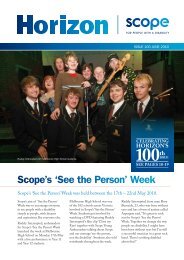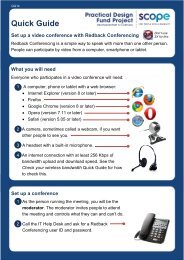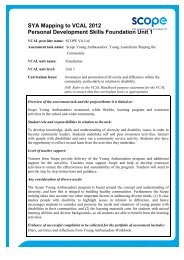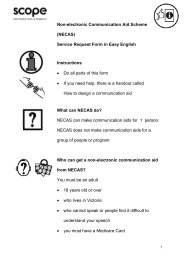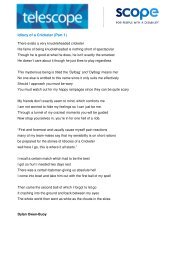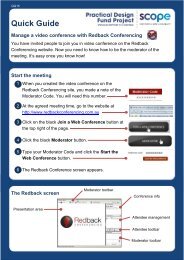Positive behaviour support Getting it right from the start
Positive behaviour support Getting it right from the start
Positive behaviour support Getting it right from the start
You also want an ePaper? Increase the reach of your titles
YUMPU automatically turns print PDFs into web optimized ePapers that Google loves.
<strong>Pos<strong>it</strong>ive</strong> <strong>behaviour</strong> <strong>support</strong>: <strong>Getting</strong> <strong>it</strong> <strong>right</strong> <strong>from</strong> <strong>the</strong> <strong>start</strong> - Facil<strong>it</strong>ators reference manual 43<br />
Frustration and loneliness caused by <strong>the</strong> inabil<strong>it</strong>y to communicate effectively may lead some<br />
people to behave in a disruptive manner. O<strong>the</strong>r people may w<strong>it</strong>hdraw <strong>from</strong> any attempt at<br />
communication. These reactions lim<strong>it</strong> <strong>the</strong>ir opportun<strong>it</strong>ies to form friendships and develop<br />
social skills.<br />
In fact, some people will have become so frustrated that <strong>the</strong>y appear to have given up trying<br />
to communicate. They may resist attempts to engage <strong>the</strong>m in conversation or misbehave when<br />
people try to use o<strong>the</strong>r forms of communication w<strong>it</strong>h <strong>the</strong>m. W<strong>it</strong>hout <strong>support</strong> <strong>the</strong>se people<br />
become more and more isolated and lim<strong>it</strong>ed in <strong>the</strong>ir participation in <strong>the</strong> commun<strong>it</strong>y.<br />
However, most people will try to influence <strong>the</strong>ir environment through some form of<br />
communication. Those w<strong>it</strong>h poor speech may make more use of gestures or sounds (ra<strong>the</strong>r than<br />
words, signs or symbols). Some may have learned that a loud shout can be more effective than<br />
persistent, pleasant requests.<br />
Some may become physically expressive by grasping and through bodily contact. These acts<br />
can be communicative, but where physical assertion is intense <strong>the</strong> acts are often misinterpreted<br />
as aggression.<br />
Your first impression may be that a particular <strong>behaviour</strong> (e.g. head banging) has nothing to do<br />
w<strong>it</strong>h communication. Perhaps <strong>it</strong> hasn’t. However if you see a person striking his head and you<br />
have never observed this before, <strong>the</strong>n you should at least consider <strong>the</strong> likelihood that <strong>the</strong> person<br />
is trying to convey some message, such as I have a headache, I am bored or I am angry.<br />
Unfortunately this <strong>behaviour</strong> can become hab<strong>it</strong>ual and <strong>it</strong>s correlation w<strong>it</strong>h communication<br />
diluted, if in <strong>the</strong> past people have not responded sens<strong>it</strong>ively to <strong>the</strong>se attempts at communication.<br />
Behaviour which may have <strong>start</strong>ed out as a communicative act merely becomes a troublesome<br />
hab<strong>it</strong> for those who live w<strong>it</strong>h <strong>the</strong> person.<br />
So much depends on how familiar you are w<strong>it</strong>h <strong>the</strong> person, your knowledge of <strong>the</strong>ir preferred<br />
methods of expressing feelings and your abil<strong>it</strong>y to interpret.<br />
People w<strong>it</strong>h profound and multiple disabil<strong>it</strong>ies often express emotion, pain or boredom in<br />
non-conventional ways. Some people who are non-speaking may turn in on <strong>the</strong>mselves and<br />
communicate by what appears to be self-absorbed <strong>behaviour</strong> (hand waving, teeth grinding or<br />
rocking). O<strong>the</strong>rs express <strong>the</strong>mselves more outwardly (throwing objects, damaging furn<strong>it</strong>ure and<br />
h<strong>it</strong>ting out at o<strong>the</strong>r residents).<br />
So called disruptive <strong>behaviour</strong> and various inappropriate <strong>behaviour</strong>s may be an attempt to in<strong>it</strong>iate<br />
social contact or gain attention. It may also be a reaction and response to what is happening<br />
(such as when expectations are unreasonable or not understood).<br />
People w<strong>it</strong>h developmental disabil<strong>it</strong>ies will sometimes have confused or conflicting feelings.<br />
Like everyone else in this s<strong>it</strong>uation <strong>the</strong>y will have difficulty expressing <strong>the</strong>mselves clearly<br />
because <strong>the</strong>y are not sure what <strong>the</strong>y are trying to convey. Understanding <strong>the</strong> ‘communicative<br />
intent’ of <strong>the</strong> <strong>behaviour</strong> requires understanding <strong>the</strong> person’s communicative abil<strong>it</strong>y (whe<strong>the</strong>r<br />
<strong>the</strong>y are intentional or unintentional communicators) a functional <strong>behaviour</strong> assessment<br />
and <strong>the</strong> systematic introduction of appropriate AAC systems that are linked to <strong>the</strong> function<br />
of <strong>the</strong> <strong>behaviour</strong>.



